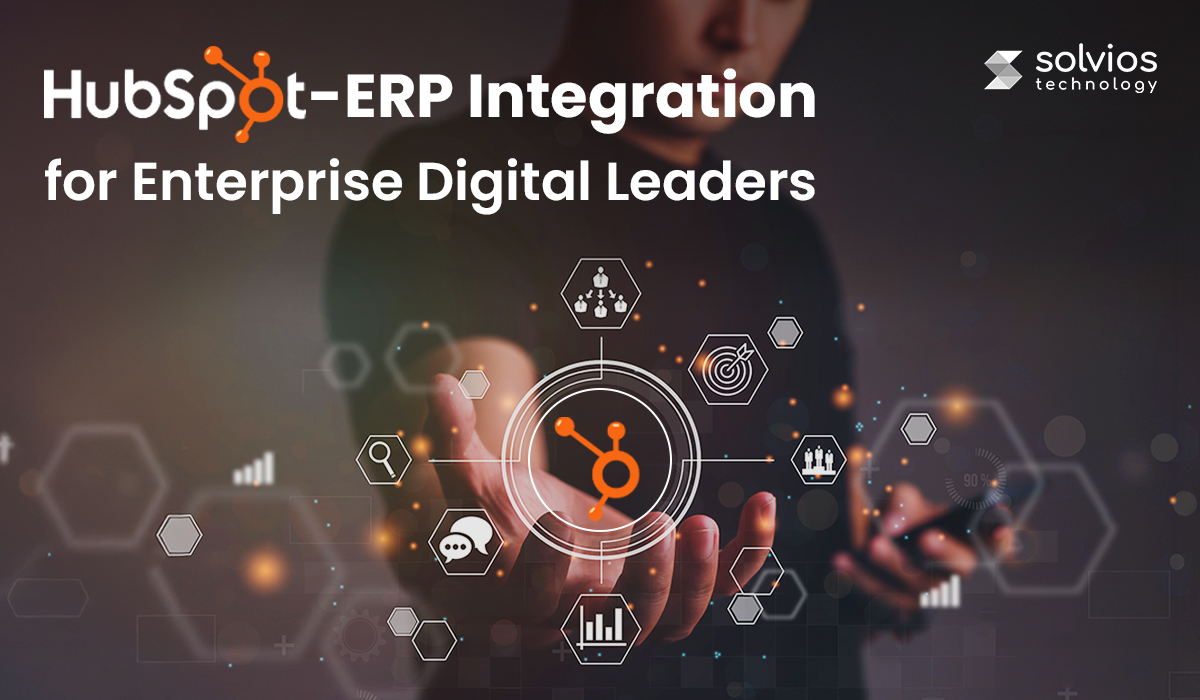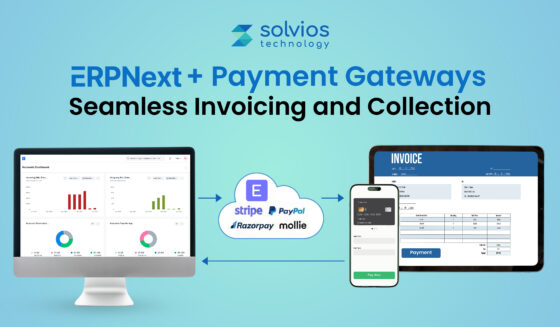
Data fragmentation is no longer a minor inconvenience; it’s a measurable loss.
Teams miss follow-ups because CRM records don’t match ERP data, inventory figures stay outdated for hours, and month-end closing drags on because systems won’t reconcile.
Each gap carries a cost: lost revenue, stalled operations, and decisions made on incomplete information.
Most teams try to fix this with plug-and-play connectors. They work briefly, until custom ERP rules, complex objects, or scale expose their limits.
Enterprises need something more than a ready-to-integrate ERP. They need a custom, API-first ERP that aligns with their workflow.
That’s where Solvios technology steps in, building the underlying architecture with HubSpot ERP, not just the connection, so your data flows cleanly and your teams stay aligned. To learn how this integration supports your business systems end-to-end, explore our hubspot consulting service page.
Let’s learn more about HubSpot ERP integration in the following sections.
The Four Pillars of Enterprise Data Flow
Modern integrations don’t fall apart because tools are weak; they break because the data moves without any defined guidelines.
Before any ERP, CRM, or analytics platform can “interact,” the foundation needs to be designed with a vision.
Here are the four major pillars that determine whether the entire ecosystem scales or collapses as volume increases.
Pillar 1: Data Governance Before Data Flow
Every reliable integration begins with discipline, not modules.
Most systems carry years of uneven data: duplicate customer names, mismatched codes, and free-text fields that were never standardized. If such unorganized data flows directly into another system, the integration will continue to deliver similar results.
However, that’s where governance steps in. It gives businesses the chance to structure their data for seamless operations.
Start by cleaning master records and using standard formats for items, customers, vendors, and transactions. Assign a single unique identifier; for example, a Customer ID master key, so every downstream system knows exactly which record it is dealing with. This one step prevents half the reconciliation issues the team may face later.
Takeaway
Governance is a crucial aspect of ERP implementation. Once ignored, even the best APIs will produce unreliable, conflicting results. Companies handling enterprise-scale setups may find insights from HubSpot for Enterprise especially useful for managing master records across platforms.
Pillar 2: Architecture Choice — The Deciding Factor
Many teams rush to link systems through built-in connectors or direct point-to-point hooks. It works at first, but the setup becomes unreliable over time.
One schema update, one field change, or one API version shift can break the entire chain. Interestingly, this is a common trap: using integrations that look neat on paper but are impractical for real-world operations.
A better approach is to use a middleware layer. It gives your system the module that handles transformation (ETL).
So whether it’s a custom-built engine or an iPaaS platform, middleware helps validate, enrich, queue, and flag errors before data reaches the target system. It also decouples platforms, so one system can evolve without halting the entire workflow.
Pillar 3: Real-Time vs. Scheduled Sync Strategy
Not every dataset requires real-time updates. Businesses planning to put every aspect of their workflow into real-time updates risk overloading servers and slowing down the user experience.
A smart architecture categorizes data into:
Real-Time (Low-Latency Needs)
- Change in order status on customer dashboards
- Updates on lead scoring from marketing platforms
- Real-time inventory update during checkout
These influence live decisions and must travel instantly.
Scheduled/Batched (Non-Urgent Loads):
- Access to financial summaries every night
- Simple ledger reconciliations
- Historical sales or aging reports
Batching reduces load, keeps costs predictable, and preserves performance during peak hours. Knowing where individual streams belong separates an efficient ecosystem from an over-engineered one. Companies looking to optimize which processes need real-time vs. batched updates can benefit from HubSpot AI for Businesses insights.
Pillar 4: Bi-Directional Security & Error Handling
Once data moves between systems, security is no longer optional. Every channel must follow strict protocols; typically, API key vaulting, OAuth 2.0 flows, and controlled scopes so each connector only sees what it must.
Next comes reliability. A mature integration is never “silent”; it logs every request, flags anomalies, and establishes a clear rollback path when the system fails.
Without these controls, a single corrupted payload can execute similar errors across three or four dependent systems before anyone notices. Robust logs, abandoned queues, and automated retries ensure that the integration can fail safely without compromising data integrity.
Is Your Business HubSpot Ready?
Understanding the core pillars of ERP implementation is crucial for any business. However, given the complexities, it is challenging for business owners to review every aspect of implementation. You can explore when to meet a HubSpot consultant to plan the integration at the right stage.
At Solvios Technology, our consultants help you prepare for a secure, bi-directional sync.
Get Your 48-Hour Integration Readiness Audit Today!
Ready to fix data gaps and streamline workflows?
Start your integration now
Mapping Critical Enterprise Objects (The Technical Execution)
Once the integration framework is in place, the next focus is the actual business objects that move between HubSpot and your ERP. This is where most integrations either become clean and predictable or challenging. Each object has its own logic, dependencies, and “non-negotiable” properties that must be mapped with intention.
A. Core Objects (Must-Haves)
Companies & Contacts: The Anchor Layer
This is where the operational truth begins. HubSpot may track conversations and engagement, but the ERP controls contracts, billing, terms, and compliance.
To keep both systems aligned, we establish a single reference ID. Sometimes it’s an ERP-generated Customer ID; sometimes it’s a custom HubSpot property. Without this foundation, deduplication becomes guesswork and ownership breaks across teams.
During mapping, we define:
- Which system becomes the “source of truth”
- How do different accounts sync
- Contact-to-company links and ownership rules
Once this layer is clean, the objects that follow fall into place much more easily.
Deals ↔ Sales Orders: The Quote-to-Cash Path
This is the highest-risk mapping in any HubSpot–ERP integration. A deal may carry product lines, contract terms, discount approvals, regional tax rules, and renewal settings, none of which can be lost during transfer.
We convert each HubSpot deal stage to the ERP’s sales order stages. For example:
- “Proposal Sent” → Draft SO
- “Closed Won” → Confirmed SO
- “Lost” → Cancel or Archive
Line items require the tightest scrutiny. Every SKU, unit of measure, price rule, and tax category is matched one-to-one with the ERP catalog. When this mapping is correct, the sales cycle stops relying on spreadsheets and double entries, and finance receives orders ready for downstream processing.
B. High-Value Objects (Advanced HubSpot–ERP Integration)
Products & Inventory: Real-Time Truth for Sales Teams
Sales representatives often quote ballpark figures to clients without having any ERP visibility in their system. Linking the product master with available stock helps remove that guesswork.
The mapping covers:
- SKU and variant structures
- Unit of Measure (UoM) conversions
- Inventory levels and reorder thresholds
- Warehouse/location-based availability
Having such synchronization between products and inventory is crucial for businesses handling large orders.
Need help with HubSpot–ERP integration?
Talk to our experts
Invoices & Payment Status: Financial Context That Improves Conversations
Customer-side teams work better when they don’t have to chase other teams for basic information. Integrating invoices into HubSpot lets them view unpaid balances, due dates, and payment history directly on the Company or Deal record.
This object typically includes:
- Status (Paid, Partially Paid, Overdue)
- Invoice date, amount, and items
- Payment terms and credit limits
- Outstanding balance
It’s a simple sync that dramatically sharpens renewal, upsell, and support conversations.
Project / Support Data: The Post-Sale Visibility Layer
ERPs usually capture operational realities, such as project milestones, delivery dates, open support cases, and warranty status. Sales and service teams rarely see this unless they chase internal updates.
By syncing selective project or support fields back into HubSpot, each team gets a unified client snapshot:
- Active project phases
- SLA or support contract details
- Open tickets and blockers
- Delivery progress or milestone delays
It’s one of the most underrated mappings, yet it’s the one that creates a true 360° customer view.
Solvios Technology: Beyond the Connector
Most integration vendors stop at the surface. They offer a connector, map a few fields, and call it a day. It works; until your ERP scales, a new module is added, or a workflow changes. That’s when the cracks show.
Solvios Technology doesn’t work that way.
Where off-the-shelf tools imitate connections, we engineer them. Our approach centers on a dedicated middleware layer tailored to your ERP’s architecture, API maturity, and long-term data model. It’s built to grow with you, not break the moment your processes evolve. Alongside seamless data and process flow, many businesses also benefit from marketing automation strategies tailored for HubSpot – a smart way to connect marketing activity directly with CRM and ERP workflows, generating consistent value as your business grows.
Want your systems to sync smoothly?
Book a consultation
What You Actually Get With Solvios Technology?
Audit & Strategy
We work on your system’s blueprint rather than jumping into integration.
Custom API Development
Our team doesn’t implement ready-made modules; we create integrations from scratch.
Post-Launch Support
We don’t leave post-implementation. Our team stays with you until your workflow is stable.
Your next integration shouldn’t be a patchwork. It should be an asset: predictable, secure, and built to last.
Partner with Solvios technology for a HubSpot–ERP integration engineered for enterprise scale.
Frequently Asked Question
Most failures happen due to unstructured data, mismatched object mappings, and reliance on basic connectors that cannot handle complex ERP rules, custom objects, or scale. An architecture-first approach solves this by using governance, middleware, and structured mapping.
If your ERP has unique workflows, custom fields, or high-volume transactions, then yes. Middleware ensures transformation, validations, queuing, and error handling so both systems stay stable as your business grows.
The essential objects include Companies and Contacts, Deals and Sales Orders, Products with Inventory, Invoices with Payment Status, and Project or Support data—together enabling a complete 360° customer view across teams.
You’re ready if you have standardized master data, clear process owners, defined source-of-truth systems, and a stable ERP structure. A readiness audit helps identify gaps before integration begins.
Not all data needs real-time sync. Use real-time updates for order status, inventory, and lead scoring, while financial summaries and historical data work best in batches to optimize performance and costs.
Solvios builds API-first custom integrations with a dedicated middleware layer, robust error handling, logging, and flexible architecture that adapts to new ERP modules, HubSpot updates, and business process changes—without breaking your workflows.
Tags
Related Blog
Want to get started with App Development?
These applications are acquiring enormous prevalence by offering hands-on enterprise mobility solutions for organizations around the globe.
Start A Conversation















